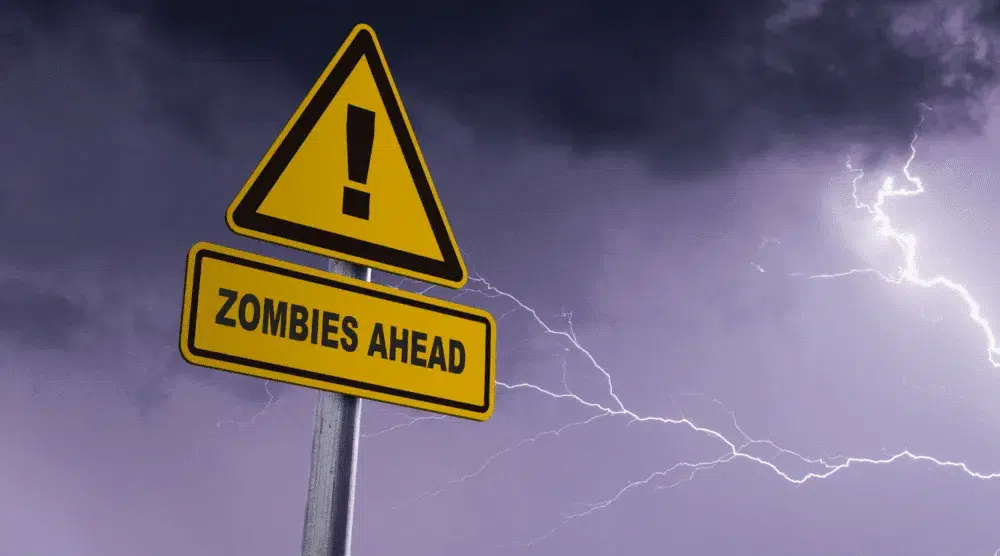The phenomenon of ‘zombie tech’ is one that is quietly pervasive in the fast-paced realm of technological advancement. While new software emerges at breakneck speeds, we are often left with outdated programs and systems silently running in the background of our operations.
The term ‘zombie tech’ may invoke images of the walking dead, but it relates to software that has fallen behind the times—programs that have stopped receiving updates and support or are no longer being used by the team, yet continue to operate within our business ecosystems.
This narrative takes a deeper dive into the world of zombie tech, specifically in relation to software and the latent dangers it poses. We will traverse the path to recognising obsolescent software and the measures that can be taken to safeguard your technological environment.
Zombie tech refers to the software that once led the vanguard of innovation but is now unsupported or not used.
It encompasses everything from legacy CRM systems to archaic accounting software incompatible with new operating systems. The threat they pose is not merely in terms of operational inefficiency but in the realm of security vulnerability. Without the reinforcement of security patches and updates, this software becomes a fertile ground for cyber threats—a virtual ‘back door’ for cyber criminals to access your systems.
The implications of continuing to retain such software are manifold. There are obvious security concerns where these programs become the weak link in your cybersecurity armour, inviting unauthorised access and data breaches. Then there’s the issue of compliance, where using outdated software that is no longer utilised could result in a data leak, falling foul of industry regulations and potentially incurring penalties. There’s also the unseen expenditure—money funnelled into keeping these systems on life support, which could instead be invested in more current solutions. It is important to remember that old systems may hold personal information on data subjects that are out of date and should no longer be held. The legal team should not just be mindful of legacy legal systems but also be aware of all corporate zombie tech and the privacy, regulatory, and data risks they pose.
A proactive stance is essential to mitigate and reduce the risks zombie tech poses. Commencing with regular technology audits is a step in the right direction. Such reviews shed light on software that’s nearing its end of life or is already there, allowing for strategic replacement plans to be formulated. Being aware of technological developments also plays a pivotal role. Staying informed about tech trends helps predict the viability of your current software suite, preparing the ground for necessary upgrades before your software turns into zombie tech. Moreover, technology audits through a privacy and data lens can help identify risks that can inform, escalate, and accelerate action plans.
Encourage the regular review of technology to ensure it is fit for purpose and meets the evolving threats and privacy regulatory requirements. For example, is the software GDPR compliant? Have they maintained their ISO certifications? These should be a priority in the current environment of cyber attacks. Services such as Security Scorecard can be utilised to understand the strength of the tech’s security, as they actively monitor an organisation’s technology stack.
Education, too, cannot be overstated.
Your team should be aware of the risks of using outdated software.
By fostering this knowledge, they become allies in identifying and transitioning away from zombie tech. And when the time comes to retire old software, it’s crucial to ensure that it’s done securely, mitigating any lingering security threats.
Even with the best-laid plans, there may be times when legacy systems persist due to their niche functions or critical role in certain processes. In such instances, these systems should be cordoned off from the network to minimise risk. Finding specialist support, fortifying your defences, and planning a careful migration to more current alternatives are the steps to take when you cannot immediately retire these systems.
To conclude, while the term ‘zombie tech’ might conjure images of a dystopian tech landscape, the risk it represents can be effectively managed. With due diligence and effective processes, businesses can evade the grasp of outdated software, ensuring that their technological practices are secure, compliant, and efficient. In the narrative of zombie tech, let it be a tale of caution from which we emerge enlightened, guided by vigilance and proactive decision-making.

